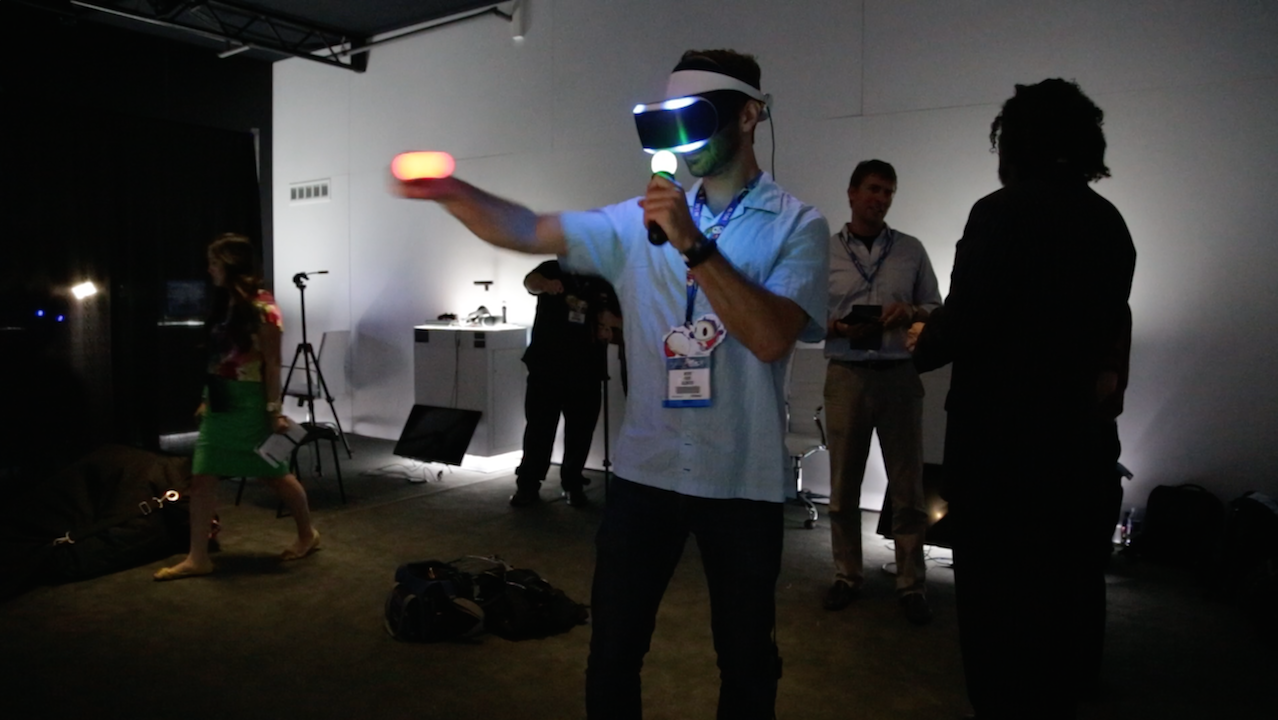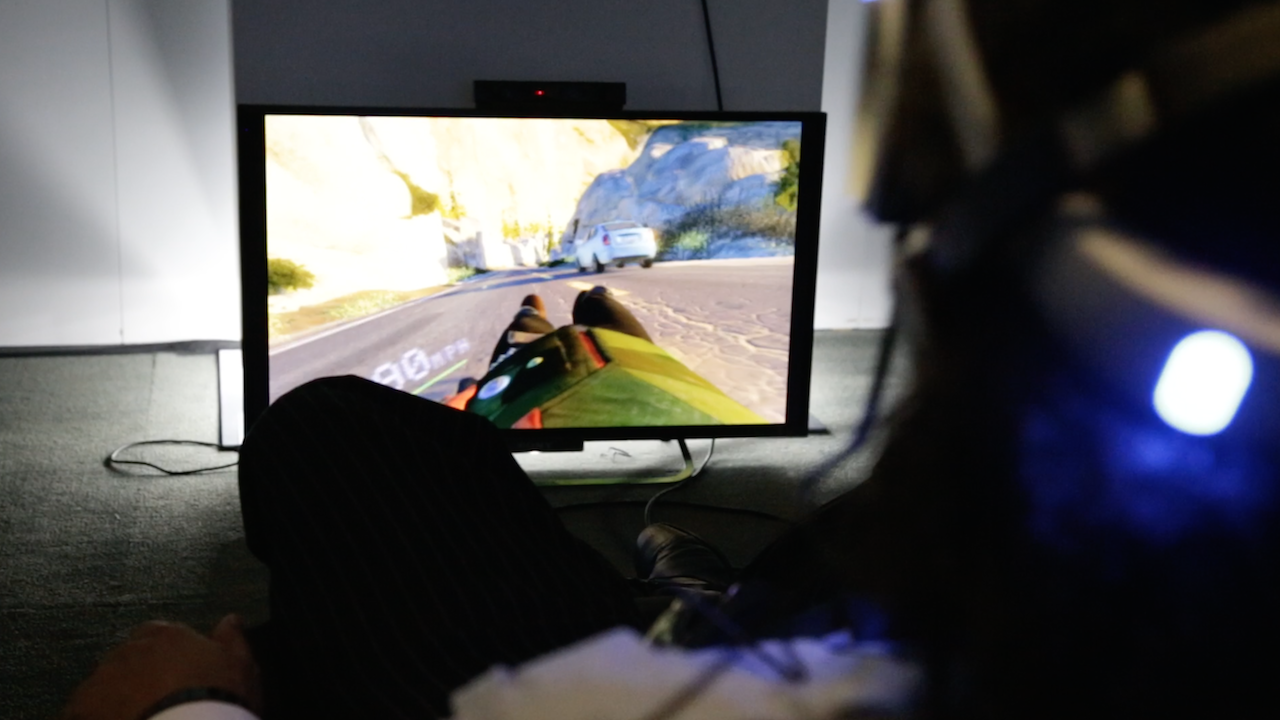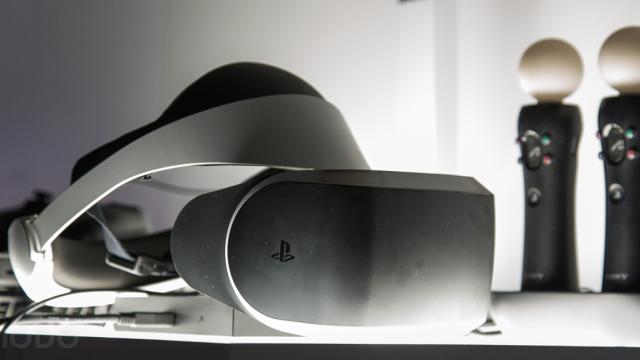When Sony announced its intentions to take Oculus Rift head-on, we were excited. The Rift (rightly) gets all of the attention and praise for its VR prowess, but a little competition would be good for the emerging technology. Today at E3 in Los Angeles we finally got to try Project Morpheus for ourselves, and it’s pretty awesome.
Admittedly, I only had it on for five-minutes stretches, but the Morpheus hardware — which looks like futuristic ski goggles — is surprisingly light and feels well balanced. I can imagine playing for hours without neck strain. That being said, Sony is very clear that the hardware is still prototype, although that was apparent enough already; some units actually had duct tape on them.
When you put the visor on, you first press the rear plastic strap in, cinching it down to get a tight fit on your head. You can also use a small wheel to dial in the fit even more precisely. Press a separate button to slide the display closer to or further from your eyes, plug a pair of headphones into the unit, and you’re ready to go.
At today’s demo I was able to try three different games. And while Morpheus won’t be released this year — or maybe not even the next — it already showed me some pretty wild stuff. We weren’t allowed to take video of what it looks like inside the goggles, but you can get a sense of what it felt like from the displays that showed off my point of view.
Castle
The first game I tried is simply being called Castle, and while it isn’t likely to ever be released, it served as a great introduction to the Morpheus. Castle uses a bunch of Sony’s available accessories to make the whole experience more immersive. It uses the PS4 Camera accessory (Sony’s answer to Kinect) to gauge your position in the room, and adjusts your view accordingly. It also uses Playstation Move motion controllers (Sony’s answer to the Wiimote) to accurately tell where your hands are. You can also use the triggers to manipulate virtual objects.

You begin Castle bare-handed, facing a knight mannequin. You can use the Move’s triggers to make your hands into fists and punch the crap out of him. Or you can grab his hands and waltz with him, should you feel so inclined. The demo was extremely responsive, and I didn’t experience any lag. On the next level you’re given a sword, and you can stab and slash off various limbs from the dummy-knight. In fact, you can grab its hand, cut off its arm, and then beat it with its own severed arm until its head falls off. What’s not to love?
You’re eventually given a spiked flail with which to bludgeon the dummy, and even a crossbow to practice your aim. Morpheus even takes into account the forces of gravity on longer shots.
The whole demo ran very smoothly until I tried to pick up a sword I dropped and ended up lifting up the entire floor beneath me. That was the first dizzying moment where suddenly I thought I might actually go stumbling across the room.
Street Luge
Next up? Street Luge, which was pure awesome. Sony piled me into a mostly flat beanbag chair so that my body position would be similar to being on an actual luge. I put the goggles and headphones on, and before I knew it I was bombing down a hill, trying to avoid traffic and other obstacles.

The controls were incredibly intuitive: You just lie there and lean in the direction you want to turn. There was basically no learning curve at all. The system was super responsive and I didn’t have any moments of lag, which can cause brain bubbles when you’re in a virtual world. Going a virtual 145km/h, I was able to slide under an oncoming big rig and look up at the axles as it was passing over head. It was really, really fun. I just wished I had a high-speed fan blowing into my face as it happen to add a little physical goodness.
EVE Valkyrie
Last up, I got to play a revamped version of EVE Valkyrie, a custom-made game Sony used for demoing Morpheus back in March. It’s now built on Unreal 4 gaming engine, and holy crap does it look good.

Basically, it’s a outer-space dogfight game. You use the standard PS4 DualShock 4 controller to fly your spacecraft, add thrust, fire guns and all that. But you use the Morpheus helmet to look around in the world and to control the missile lock. Keep the enemy in your sights for a few seconds, and your target is locked, whereupon you can blow them to smithereens.
This is just a fantastic way to play. Not only do you feel immersed in the world, but being able to look around and lock onto a target while you’re flying in a different direction (or gunning down another target) literally adds a whole new dimension. It basically allows you to play in a way that would be otherwise impossible, which means you have to teach your brain a new trick to get really good at it.
One of the subtlest but best features of Morpheus is that it incorporates 3D sound. This is a buzzword we’ve heard applied to tablets and all kinds of other things, but here it works, and it’s legitimately great. In Eve, for example, when you’re firing your machine gun, if you turn your head to look to the left, the audio shifts over toward your right ear. It adds to the depth of reality you experience while you’re playing.
So what’s the cumulative effect? Playing these games raises your pulse in a way that playing on a flat screen (even a very big one) just doesn’t. By altering your sense of reality, Morpheus successfully manages to trigger some of your fight or flight reflexes. Street Luge definitely caused my adrenaline to spike, and Eve Valkyrie gave me that panicked, “I’m being chased!” feeling. Naturally, you know it’s just a game, so you don’t fully freak out or, but because it feels so much more real, you can’t help but giggle as your body’s involuntary responses. It’s a hoot.
Now, it’s certainly not anywhere near perfect yet. Currently, the display in there is 1080p, but that’s split between your two eyes, so it ends up being a little grainy. Add to that the fact that your eyeballs are basically pressed up against the screen, and we’re a long way from a “retina display.” Pixels are still very visible. And it has a little bit of the “looking through a screen door” effect we’ve seen on the Oculus, as well.
It’s by no means bad. In fact, it’s quite good, but VR is a technology that is clearly begging for 4K. We’ve probably got at least a year before we see this thing hit the shelves, so who knows? Maybe it will be incorporated before then.
Sony’s Jeff Stafford told me that Morpheus, more than any other PlayStation product, is going to be driven by developers. He doesn’t simply want to port Sony’s popular games over to Morpheus (though, you can bet that they will). He wants to see people creating worlds specifically to maximise VR’s potential.
We’re just seeing the beginning of this now, but even these early glimpses are potent omens of the awesomeness to come.
